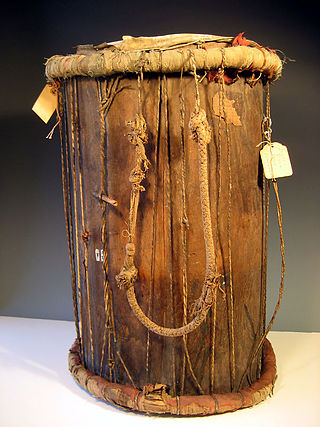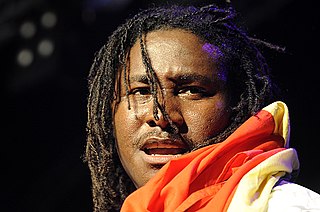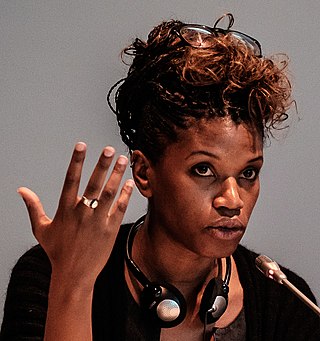
Senegal's music is best known abroad due to the popularity of mbalax, a development of conservative music from different ethnic groups and sabar drumming popularized internationally by Youssou N'Dour.
Senegalese hip hop is a form of hip hop that originated in Senegal in the early 1980s. When hip hop first hit the scene in Africa, it went from merely being a fad, to a more social and political movement. Amongst the most influential leaders of this movement were artists from the country of Senegal. With the modernization of the country, and the rise in media, the youth of Senegal were able to embrace a new form of expression.

Daara J are a Senegalese rap duo that consists of N'Dongo D and Faada Freddy. Their music takes influence from hip hop, Afro-Cuban rhythms, and reggae and is performed in English, French, Spanish, and Wolof.

Positive Black Soul is a hip hop group based in Dakar, Senegal, one of the first such collectives in the country. Founded in 1989, the group is composed of Didier Sourou Awadi and Amadou Barry, both of whom had previously been in other hip hop groups. They perform in the English, French, and Wolof languages and use traditional Senegalese instruments as part of their songs. Political and social activism have played important roles in the group since it was founded.

Didier Awadi is a Senegalese rapper and a significant figure in Francophone West African hip hop. As a founding member of Positive Black Soul (PBS) with Duggy Tee, Awadi toured around the world contributing to the international popularity of Hip Hop Galsen. Awadi works as a solo artist, accompanied by his crew PBS Radikal. He participates in the Senegalese music industry through his label, recording studio, and rehearsal space, Studio Sankara. Awadi offers a conscious and revolutionary style of music strengthened by articulated and rooted messages. His motivation and inspiration is grounded in the Burkinabé revolutionary Thomas Sankara's phrase: "Let's dare to invent our future!"

Negrissim' is a hip hop crew from Cameroon formerly based in Dakar, Senegal, despite their members travelling regularly between Europe and Africa.
United Artists for African Rap is a collective of 17 hip hop artists coming from ten different countries in West Africa and who are committed to use their voices and music for Africa’s development. With the support of the Non Governmental Organization PLAN International, they are engaged in a public awareness campaign relating to Children’s rights and youth problems. With respect, they realized in 2006 the first ever hip hop musical comedy show “The extraordinary Stories of Poto-Poto Children”.

Pee Froiss is a hip hop group formed in Dakar, Senegal in 1993. It was originally a dance group which refocused on rap. Early on, Pee Froiss received mentorship from the Senegalese rap luminaries Positive Black Soul, which produced their first album Wala Wala Bok? in 1996. The band's music is rapped in Wolof, French, and English and features traditional Senegalese instruments such as the kora as part of its instrumentation. Pee Froiss was one of the first rap groups to include a female performer in their lineup, Sistah Joyce. The group created all of their own music videos with very sparse resources, the first of which was released with their first album. Wala Wala Bok? is considered a classic of Senegalese hip hop. Alongside, Positive Black Soul and Daara J, Pee Froiss emerged as trailblazers in Senegalese hip hop, galvanizing a generation by intertwining the genre with themes of political resistance and social activism.
The Gambian hip hop scene is a relatively new scene in African hip hop which developed in the mid-1990s and was heavily influenced by American hip hop and Senegalese hip hop. Gambian hip-hop has been heavily influenced by international music scene including worldbeat, Senegalese wolof music, and American hip hop, as well as traditional Gambian mbalax and n'daga music. Dominican merengue and Jamaican reggae, ragga, and dancehall have also influenced the development of Gambian hip-hop.
Lord Alajiman is a Senegalese hip hop artist and entrepreneur. He is one of the member of the now internationally known group Daara J with whom he performed and toured throughout the world until 2008 when the group split. Since then, Alajiman evolves in a solo career while contributing to the development of the music sector in Senegal. In 2009, he created Baatine Agency, a communication agency centred on Karbone 14, which repeatedly organised the shows of Morgan Heritage in Dakar. Citing Cheikh Anta Diop, Alajiman claims to understands the development – one oneself or a sector in general – as ”the acceptance of new elements”.
ALIF is the pioneer female hip hop trio of Hip Hop Galsen. Emerging in the late mid-1990s, ALIF offered a feminine and feminist flavour to Hip Hop Galsen encouraging women to play their part in the movement. The group split beginning of 2010 after thirteen years.
Baay Sooley is a hip-hop dancer from Senegal. He has toured internationally as a dancer of the Positive Black Soul (PBS) crew. He choreographed the hip hop musical comedy "The Extraordinary Stories of the Poto-Poto Children". and created the street wear brand "Bull Doff".
Gee Bayss is one of the pioneer DJs in West Africa. Member of the group, Pee Froiss, he toured throughout the world with his sure-fire turntablism which had crowds jumping whenever the group was performing. Combining solo projects with international tours of the Pee Froiss, Gee Bayss is actively engaged in transmitting his deejaying art to the younger generations.
Keyti is one of the first and most prominent hardcore hip hop artists in Senegal. With his group Rap’Adio, he offered a radical approach to Hip Hop Galsen violently recalling the initial purpose of hip hop as a means to denounce society’s flaws. Still radically critical, though less hardcore, Keyti now evolves in solo. He is part of the West African hip hop collective AURA and performs in its well-known musical comedy The Extraordinary Stories of Poto-Poto Children.
K-ID is a Senegalese artist and one of the two members of the group Chronik 2H. He stands as one of the hip hop entrepreneur actively contributing to the structuring of the music sector in Dakar. Well known for his talents as musical producer, having realised several tracks and albums for local hip hop artists, K-ID has now intensified his participation in the local music economy with the creation of his structure Oracle Vision Future, specialised in audiovisual production. Through this new initiative, K-ID expresses his desire to give a new and professional impulsion to the Hip Hop Galsen and, the African Hip Hop in general.
Matador is one of the most prominent figures of underground Hip Hop in Senegal. Founding member of the Thiaroye’s group, WA BMG 44, Matador has toured throughout the world gaining an international recognition from the underground hip hop scenes abroad. Since 2006, his struggle to represent the voiceless youth of his home country has taken a renewed turn with the creation of his structure, Africulturban in Pikine. Through this space dedicated to the youth, Matador reiterates his social and political engagement while pursuing his role of “Number One System Enemy” and “General Major Chief of the Dying People Army”.
Moona is a West African rapper. Known for her flow, sharp and poetic lyrics as well as for her active involvement with the youth, Moona is an active member of United Artists for African Rap (AURA) in which she represents her native Benin. Besides, Moona is the only female rapper to have been selected by Africa Unsigned among artists of the continent to receive support for their next production.
Simon Bisbi Clan is one of the most visible hip hop artists on the contemporary scene of Hip Hop Galsen. After his beginnings in Dakar, Simon grows from his diverse experiences on other hip hop scenes abroad during five years before coming back to his hometown. Since his return, he has been intensively contributing to the development of the musical sector in Dakar with the creation of his LLC, 99 Records, a structure dedicated to the promotion of Senegalese urban music and centred on the label “Djolof 4 Life Entertainment”.

Rama Thiaw is a Senegalese filmmaker and screenwriter. She is known for her 2009 documentary Boul Fallé, la Voie de la lutte and her most recent documentary The Revolution Won’t be Televised (2016).

Wagëblë are a Senegalese hip hop act. Their debut album was released in 2003.








